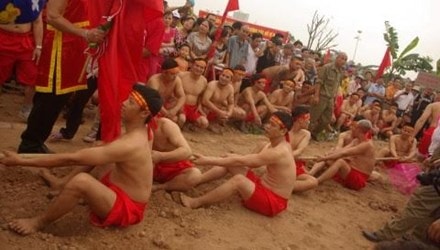Vietnam's tug of war officially becomes world heritage
At the 10th session of the UNESCO 2003 Intergovernmental Committee for the Safeguarding of Intangible Cultural Heritage, held this evening, December 2 (Vietnam time) in Namibia, Vietnam's traditional flag-raising game and ceremony were officially listed on the Representative List of Intangible Cultural Heritage of Humanity.
 |
| Tug of war ritual in Long Bien district, Hanoi |
This is an international profile, Vietnam cooperated with Cambodia, Philippines, and South Korea to build. This ceremony is expressed differently in each country: in South Korea, it is more grand and elaborate. Cambodia organizes the ceremony at the beginning of the Khmer New Year.
Nowadays this game is a sport, but its origin has a spiritual meaning. The localities participating in building the profile of Vietnam: Long Bien District and Soc Son District of Hanoi City, Binh Xuyen District of Vinh Phuc Province, Bac Ninh City, Bac Ha District of Lao Cai Province.
The sitting tug of war ritual in Ngoc Tri village, Thach Ban ward, Long Bien, Hanoi is held on the 3rd day of the 3rd lunar month every year, during the Tran Vu Temple Festival. Mr. Ngo Quang Khai, Head of the Tran Vu Temple Relic Management Board, said that it is not as simple as the sport tug of war that people mistakenly think. This ritual requires many strict factors from choosing people to practicing the ritual.
“The ritual originates from the story of Ngoc Tri village, where there was a drought. All 12 wells were dry, leaving only one well with water. Afraid that other neighbors would take water, the neighbors with water sat down and held buckets of water. Later, it became a performance of a tug-of-war, praying for favorable weather,” said Mr. Khai.
Associate Professor, Dr. Nguyen Van Huy, member of the National Heritage Council, who participated in the construction of the dossier, said: “Several countries gathered together to watch the tug-of-war rituals, and we were surprised at the foundation of Southeast Asian culture. Many ritual activities, including sitting tug-of-war, are clearly expressed in the East Asian foundation, which is the wish for good crops, good health for everyone, and peace for the village.”
Tug of war rituals in each region have their own characteristics. The ritual in Lao Cai is imbued with the culture of the Tay and Giay people. Tug of war in Vinh Phuc and Hanoi is of the Kinh people but also has its own characteristics: in Vinh Phuc, the tug of war players sit on a pre-dug hole, using a rope. In Long Bien, people sit on the ground. In Soc Son, people use bamboo.
According to Tien Phong online
| RELATED NEWS |
|---|
